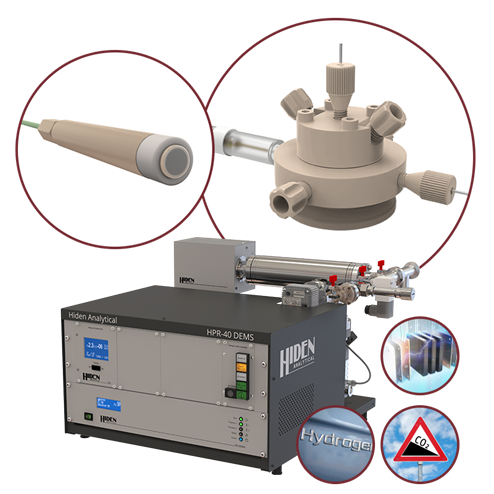AZoMaterials speaks to Jim Melling, Senior Applications Specialist at Hiden Analytical, about how advanced quadrupole mass spectrometry is transforming real-time gas and plasma analysis across modern materials workflows.
Can you give us a brief overview of the HPR-40 DEMS system and where the new ECL-Series fits within the broader Hiden Analytical portfolio?
The HPR-40 DEMS is a turnkey differential electrochemical mass spectrometry system designed for real-time, in situ analysis of gases and volatile species during electrochemical reactions. It uses high-performance mass spectrometry with advanced electrochemical cells, enabling the detailed study of reaction mechanisms, gas evolution, and selectivity.
The ECL-Series, comprising the ECL-Static, ECL-Insight, and ECL-Probe, represents the latest generation of electrochemical cell technology.
Designed specifically for direct coupling with the HPR-40 DEMS, the cells and probe provide researchers with exceptional flexibility to study static, flowing, and custom setups. Together, they form a comprehensive, modular solution that fits seamlessly into Hiden’s broader portfolio of gas analysis and plasma diagnostic systems.
What specific advancements or capabilities does this series introduce over previous versions of the HPR-40 DEMS?
The new ECL-Series has significant upgrades in both temporal response and sensitivity. A key improvement is the direct connection between the electrode and the mass spectrometer, which dramatically shortens response times and enhances signal accuracy.
The ECL-Insight cell, for instance, supports rapid voltage sweeps of up to 100 mV/s and operates at currents up to 100 mA/cm2 without bubble interference. This is ideal for fast, high-current studies such as hydrogen evolution or CO2 reduction.
The modular inlet and membrane designs also make it simple to adapt the system for different electrochemical processes, using the same core spectrometer and software for all experiments.

Image Credit: Hiden Analytical
How does the ECL-Series improve temporal resolution and sensitivity for researchers working with fast electrochemical reactions?
Temporal precision is one of the standout features of the ECL-Series. By positioning the working electrode directly on a gas-permeable PTFE membrane, the system captures gaseous products almost instantly, with response times of under 100 milliseconds.
The dual-chamber configuration of the ECL-Insight cell, coupled with its gold-sputtered membrane, ensures highly efficient product collection and quantitative measurement.
Meanwhile, the ECL-Probe enables direct dissolved gas analysis inside standard or custom cells, maintaining sensitivity even in challenging electrolytic environments. Together, these features let researchers observe rapid reaction dynamics that would otherwise be missed.
Can you elaborate on the significance of performing real-time monitoring of gaseous and volatile species directly at the working electrode? How does this benefit applications like fuel cell development or battery research?
Monitoring gas evolution directly at the working electrode allows scientists to synchronise electrochemical and spectrometric signals with precision. This real-time feedback reveals how current and potential correlate with product formation. This is critical for understanding reaction pathways and catalytic efficiency. Direct analysis leads to faster optimization and greater performance in energy-related materials.
How important was modularity in the design of the ECL-Series, and what feedback have you received from users so far?
Modularity is a key aspect of the design. Researchers often need to transition between experiments quickly, and the ECL-Series enables that with interchangeable cells, easy connections, and software-driven control. Users can switch between static, flowing, or dissolved-gas configurations with minimal downtime.
Feedback from early adopters has been overwhelmingly positive. They value the plug-and-play setup, intuitive software integration, and the ability to tailor electrode materials and geometries. It’s made the system more accessible to new users and more powerful for experienced electrochemists.
With growing demand for operando and in situ techniques, how does the ECL-Series support more complex or evolving electrochemical workflows?
The HPR-40 DEMS with ECL-Series was designed specifically for operando and in situ analysis. Its fully integrated architecture allows for the synchronized acquisition of current, potential, and mass spectra, offering a unified view of electrochemical reactions as they occur.
The system’s adaptability, through its multiple cell types and inlet options, means it can accommodate everything from small-scale laboratory experiments to complex, high-throughput studies. Whether for catalyst development, CO2 reduction, or long-term battery cycling, the ECL-Series provides a reliable foundation for advanced research.
What types of users or research areas stand to benefit the most from adopting the new ECL-Series setup? Are there any emerging fields showing interest?
The system is particularly valuable to scientists working in energy conversion and storage, including research on fuel cells, electrocatalysis, corrosion, and CO2 reduction. Battery developers also benefit from its ability to correlate gas formation with electrochemical performance in real time.
Electrochemical chlorination (e.g., selective C-H chlorination of alkanes for fine chemical synthesis) is a growing area in green electrosynthesis, where DEMS reveals radical mechanisms and product selectivity with precise temporal control. This highlights how the ECL-Series is proving equally useful in both academic and industrial R&D environments.
How do you see the ECL-Series evolving in response to trends in electrochemical research, and are there any upcoming enhancements or complementary technologies being developed at Hiden Analytical?
Electrochemical research is becoming more interdisciplinary, with growing interest in operando studies, hybrid energy systems, and automation. The ECL-Series is well-positioned to evolve with these trends. Future enhancements may focus on expanding cell compatibility, improving data-handling efficiency, and integrating faster, more automated workflows.
Hiden Analytical continues to develop software and hardware innovations that streamline data synchronisation and analysis across platforms. The goal is to make advanced in situ measurement as straightforward and reliable as possible, empowering researchers to focus on discovery rather than instrumentation.
For more information about the HPR-40 DEMS and ECL-Series, visit www.hidenanalytical.com.
About the Speaker

Jim Melling is a Senior Applications Specialist at Hiden Analytical with 17 years’ experience using mass spectrometry for gas analysis. He specialises in Differential Electrochemical Mass Spectrometry (DEMS), Membrane Inlet Mass Spectrometry (MIMS) and multi-stream Bioprocess Mass Spectrometry. His goal is to make mass spectrometry more accessible through smart software integration and design of practical tools and techniques, enabling more users to explore and monitor gas evolution in electrochemical and biological processes.

This information has been sourced, reviewed, and adapted from materials provided by Hiden Analytical.
For more information on this source, please visit Hiden Analytical.
Disclaimer: The views expressed here are those of the interviewee and do not necessarily represent the views of AZoM.com Limited (T/A) AZoNetwork, the owner and operator of this website. This disclaimer forms part of the Terms and Conditions of use of this website.